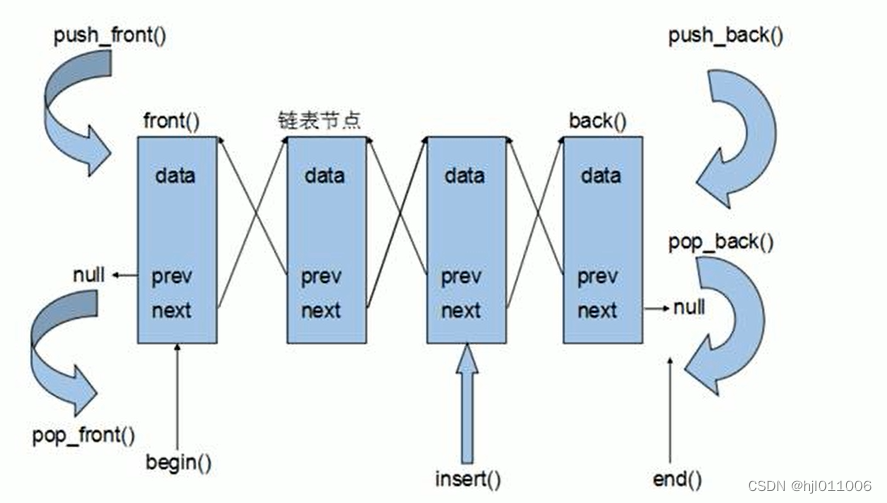一、list基本概念
1. 功能:将数据进行链式存储
2. 链表
链表:
????????????????是一种物理存储单元上非连续的存储结构,数据元素的逻辑顺序是通过链表中的指针链接实现的
链表的组成:
????????链表是由一系列结点组成
结点的组成:
????????一个是存储数据元素的数据域,另一个是存储下一个结点地址的指针域
3. 结构
STL中的链表是一个双向循环链表
由于链表的存储方式不是连续的内存空间,因此链表list中的迭代器只支持前移和后移,属于双向迭代器

?4. list优缺点:
list的优点:
- 可以对任意位置进行快速插入或者删除
- 采用动态存储分配,不会造成内存浪费和溢出
- 链表执行插入和删除操作十分方便,修改指针即可,不需要大量移动数据
list的缺点:
- 容器遍历速度没有数组快,占用空间比数组大
- 链表灵活,但是空间(指针域)和时间(遍历)额外耗费比较大
5. 特别:
list容器的插入操作和删除操作都不会造成原有list迭代器的失效,这在vector是不成立的。
二、list构造函数
- list<T>? lst;???????????????????????????? // list采用模板类实现,对象的默认构造方式
- list(beg,? end);??????????????????????? // 构造函数讲(beg,end)区间内的元素拷贝给本身
- list(n,? elem);????????????????????????? // 构造函数将n个elem拷贝给本身
- list(const? list? &? lst);??????????? // 拷贝构造函数
#include<iostream>
#include<list>
#include<algorithm>
using namespace std;
//遍历
void print_List(list<int> &l)
{
for(list<int>::iterator it = l.begin();it!=l.end();it++)
{
cout<<*it<<" ";
}
cout<<endl;
}
int main()
{
list<int> l; // 默认构造
// 添加数据
l.push_back(10);
l.push_back(20);
l.push_back(30);
l.push_back(40);
l.push_back(50);
// 遍历容器
print_List(l);
// 区间构造
list<int> L2(l.begin(),l.end());
print_List(L2);
// 拷贝构造
list<int> L3(L2);
print_List(L3);
// n 个 elem 的方式
list<int> L4(10,100);
print_List(L4);
return 0;
}
?三、list赋值和交换
- assign(beg,? end);??????????????????????????? ? ? ? // 将(beg,end)区间内的数据拷贝赋值给本身
- assign(n,? elem);?????????????????????????????????????? // 将n个elem拷贝赋值给本身
- list? operator=(const? list? &? lst);??????????? // 重载等号操作符
- swap(lst);???????????????????????????????????????????????? // 将lst与本身的元素互换
#include<iostream>
#include<list>
#include<algorithm>
using namespace std;
//遍历
void print_List(list<int> &l)
{
for(list<int>::iterator it = l.begin();it!=l.end();it++)
{
cout<<*it<<" ";
}
cout<<endl;
}
int main()
{
list<int> L1;
for(int i=0;i<10;i++)
{
L1.push_back(i);
}
print_List(L1);
// 赋值
list<int> L2;
L2 = L1; // operator= 进行赋值
print_List(L2);
// assign 区间赋值
list<int> L3;
L3.assign(L2.begin(),L2.end());
print_List(L3);
// assign n 个 elem 的方式
list<int> L4;
L4.assign(10,100);
print_List(L4);
// 交换
cout<<"交换前L3 和 L4:"<<endl;
print_List(L3);
print_List(L4);
cout<<"交换后L3 和 L4:"<<endl;
L3.swap(L4);
print_List(L3);
print_List(L4);
return 0;
}?四、list大小操作
- size();????????????????????????????????? // 返回容器中元素的个数
- empty();???????????????????????????? // 判断容器是否为空
- resize(num);?????????????????????? // 重新指定容器的长度为num,若容器变长,则以默认值0填充新的位置
????????????????????????????????????????? // 如果容器变短,则末尾超出容器长度的元素被删除
- resize(num,? elem);??// 重新指定容器的长度为num,若容器变长,则以elem值填充新的位置
???????????????????????????????????????? // 如果容器变短,则末尾超出容器长度的元素被删除
#include<iostream>
#include<list>
#include<algorithm>
using namespace std;
//遍历
void print_List(list<int> &l)
{
for(list<int>::iterator it = l.begin();it!=l.end();it++)
{
cout<<*it<<" ";
}
cout<<endl;
}
int main()
{
list<int> L1;
for(int i=0;i<10;i++)
{
L1.push_back(i);
}
print_List(L1);
// 判断容器是否为空
if(L1.empty())
cout<<"L1 为空"<<endl;
else
cout<<"L1 不为空"<<endl;
// 元素个数
cout<<"L1 中元素的个数:"<<L1.size()<<endl;
// 重新指定大小
L1.resize(11); // 如果超出原本的大小,多出的部分默认由0 填充
print_List(L1);
L1.resize(15,99); // 重载版本,指定填充内容
print_List(L1);
L1.resize(6);
print_List(L1); // 如果比原本的大小小,那么多出的部分被删除
return 0;
}
?五、list插入和删除
- push_back(elem);???????????? // 在容器尾部加入一个元素
- push_front(elem);??????????? // 在容器开头插入一个元素
- pop_back();?????????????????????? // 删除容器中最后一个元素
- pop_front();????????????????????? // 删除容器第一个元素
- insert(pos,? elem);?????????????????? // 在pos位置插入elem元素的拷贝,返回新数据的位置
- insert(pos,? n,? elem);????????????? // 在pos位置插入n个elem数据,无返回值
- insert(pos,? beg,? end);??????????? // 在pos位置插入(beg,end)区间内的数据,无返回值
- erase(beg,? end);????????????????????? // 删除(beg,end)区间内的数据,返回下一个数据的位置
- erase(pos);?????????????????????????????? // 删除pos位置的数据,返回下一个数据的位置
- remove(elem);??????????????????????? // 删除容器中所有与elem值匹配的元素
- clear();?????????????????????????????????? // 移除容器中所有的数据
#include<iostream>
#include<list>
#include<algorithm>
using namespace std;
//遍历
void print_List(list<int> &l)
{
for(list<int>::iterator it = l.begin();it!=l.end();it++)
{
cout<<*it<<" ";
}
cout<<endl;
}
int main()
{
list<int> L1;
for(int i=0;i<10;i++)
{
L1.push_back(i);
}
print_List(L1);
// 头插
L1.push_front(100);
// 尾插
L1.push_back(200);
print_List(L1);
/*
头删
L1.pop_front();
尾删
L1.pop_back();
*/
//insert 插入
L1.insert(++L1.begin(),1000); // 第一个参数是迭代器(位置),第二个参数是插入的内容
print_List(L1); // 迭代器可以偏移
// 删除
L1.erase(L1.begin()); // 迭代器可以偏移
list<int>::iterator it = L1.begin(); // 设置it为迭代器
L1.erase(it);
print_List(L1);
// 移除
L1.push_back(10000);
print_List(L1);
L1.remove(10000); // 移除list中所有的指定内容
print_List(L1);
// 清空
L1.clear();
print_List(L1); // 清空所有的内容
return 0;
}
?六、list数据存取
list本质是链表,不是连续线性空间存储数据,迭代器也不支持随机访问
list不支持[]和at()访问
- front();????????? // 返回第一个元素
- back();?????????????? // 返回最后一个元素
#include<iostream>
#include<list>
#include<algorithm>
using namespace std;
//遍历
void print_List(list<int> &l)
{
for(list<int>::iterator it = l.begin();it!=l.end();it++)
{
cout<<*it<<" ";
}
cout<<endl;
}
int main()
{
list<int> L1;
for(int i=0;i<10;i++)
{
L1.push_back(i);
}
print_List(L1);
// 访问第一个和最后一个元素
cout<<"第一个元素为:"<<L1.front()<<endl;
cout<<"最后一个元素为:"<<L1.back()<<endl;
// 验证迭代器不能随机访问
list<int>::iterator it = L1.begin();
it++; // 只能++或者--不能+1
return 0;
}
?七、list反转和排序
- reverse();??????????? // 反转链表
- sort();?????????????????????? // 链表排序
#include<iostream>
using namespace std;
#include<list>
#include<algorithm>
//遍历
void print_List(list<int> &L)
{
for(list<int>::iterator it = L.begin();it!=L.end();it++)
{
cout<<*it<<" ";
}
cout<<endl;
}
// list容器的反转和排序
void test01()
{
list<int> L1;
for(int i=0;i<10;i++)
{
L1.push_back(i);
}
cout<<"反转前:"<<endl;
print_List(L1);
// 反转
L1.reverse();
cout<<"反转后:"<<endl;
print_List(L1);
}
// 伪函数
bool my_compare(int v1,int v2)
{
// 降序 --> 就让第一个数大于第二个数
return v1 > v2;
}
void test02()
{
// 排序
list<int> L2;
L2.push_back(5);
L2.push_back(78);
L2.push_back(2);
L2.push_back(98);
L2.push_back(65);
cout<<"排序前:"<<endl;
print_List(L2);
// sort(L2.begin(),L2.end()); // 所有不支持随机访问迭代器的容器,都不可以用标准算法
// 不支持随机访问的迭代器的容器,内部会对应提供一些算法
L2.sort(); // 默认升序
cout<<"升序排序后:"<<endl;
print_List(L2);
L2.sort(my_compare); // 降序的操作
cout<<"降序排列后:"<<endl;
print_List(L2);
}
int main()
{
test01();
test02();
return 0;
}
八、附加一个排序案例
#include<iostream>
using namespace std;
#include<list>
#include<algorithm>
class person
{
public:
person(string name,int age,int height)
{
this->name=name;
this->age=age;
this->height=height;
}
string name;
int age;
int height;
};
void print_list(list<person>&L)
{
for(list<person>::iterator it=L.begin();it!=L.end();it++)
{
cout<<"姓名:"<<it->name<<"\t年龄:"<<it->age<<"\t身高:"<<it->height<<endl;
}
}
bool compare_person(person &p1,person &p2)
{
// 按照身高降序
if(p1.age==p2.age)
return p1.height>p2.height;
// 按年龄升序
return p1.age<p2.age;
}
void test01()
{
list<person> L;
person p1("刘备",35,175);
person p2("曹操",45,180);
person p3("孙权",40,170);
person p4("赵云",25,190);
person p5("张飞",35,189);
person p6("关羽",35,200);
L.push_back(p1);
L.push_back(p2);
L.push_back(p3);
L.push_back(p4);
L.push_back(p5);
L.push_back(p6);
// 排序前
print_list(L);
// 排序后
cout<<"按年龄排序后:"<<endl;
// 操作自定义类型的数据排序要指定排序的规则
L.sort(compare_person);
print_list(L);
// 重新定义排序,在年龄相同的情况下,按照身高进行降序排列
cout<<"多重条件后的排序:"<<endl;
L.sort(compare_person);
print_list(L);
}
int main()
{
test01();
return 0;
}